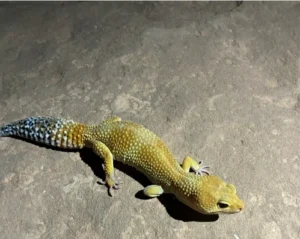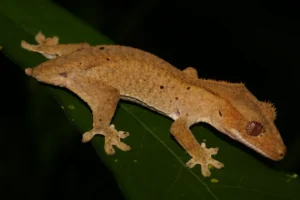It’s late at night, and you’re quietly watching your gecko move across its tank. Its little feet stick to the glass like magic, and for a moment, it’s almost unreal how smooth and agile it looks.
Then something catches your eye, its skin seems paler than usual. You start to wonder: do geckos actually turn white when they die?
Yes, geckos can look pale or even white when they die, but it’s not like flipping a switch. When a gecko dies, blood stops moving, and chemical changes start in the body. That can make the skin look lighter or washed-out. This pale look mostly happens because blood isn’t flowing through the tiny vessels under the skin anymore.
But it’s a bit more complicated than just “gecko turns white.” Geckos have special layers in their skin that affect how their colors show, even when they’re alive. And these same layers also change how they look after death.
Gecko Skin Is Like a Tiny Light Show
One thing people don’t always realize is that a gecko’s skin isn’t just one color.
Many geckos, like leopard, crested geckos, or tokay geckos have layers in their skin that reflect light in interesting ways.

Beneath the surface, there are cells called chromatophores that hold pigments, and cells called iridophores that reflect light. Together, these layers make the bright patterns and colors you love to watch.
When a gecko dies, circulation stops first. Blood no longer flows through the tiny vessels, and the skin loses its natural rosy or golden glow.
Since the pigments in the skin partly rely on living cells to stay vibrant, the skin can look pale or grayish; sometimes even whitish, depending on the species.
It’s a bit like turning off a light in a room. The furniture doesn’t disappear, but the colors suddenly look different.
Your gecko’s usual bright spots, like the gold on a leopard gecko or the reds on a crested gecko, may fade to something much paler.
Not All Geckos Turn White
Not every gecko will look white when it dies. How pale it looks depends on its species, age, and health before death.
For example, geckos with naturally lighter skin, like some leopard gecko morphs, might just look slightly duller instead of stark white.

Darker geckos, like tokay or gargoyle geckos, might fade to grayish tones instead of pure white. Patterns can still show but muted, giving a ghostly look.
The environment matters too. If a gecko dies in a dry place, its skin can shrink and look even paler.
A gecko that dies in a more humid area might keep some of its original color for a little while.
Why Geckos Don’t Turn White Immediately
A common misconception is that geckos turn white the moment they die. In reality, it’s gradual. Right after death, muscles relax and circulation stops.
The skin may still have some color for a few minutes to an hour, depending on the species.
After that, as cells break down and blood stops moving, the skin fades. Sometimes the eyes, normally bright and shiny, also cloud over, making the gecko look even paler.
So if your gecko is lying still and looks a little lighter than usual, it doesn’t always mean it’s dead.
Geckos can also get pale temporarily from stress, shedding, or temperature changes.
Stress and Color Change Can Be Confusing
Geckos are really good at changing color. Not like chameleons, but many species lighten or darken depending on mood, temperature, or health. A stressed gecko can get very pale.

Imagine your gecko has been hiding under a rock for hours. Its skin might lighten as its body tries to handle stress and temperature. Or if it’s about to shed, many geckos get a milky, ghost-like layer over their skin.
Because of this, it’s easy to mistake a pale gecko for one that’s dead. Always check for breathing, movement, or a heartbeat. You can often see a tiny pulsing in the chest if it’s alive.
Other Signs of Death in Geckos
Color alone isn’t enough to tell if a gecko has died. Look for other signs:
-
No breathing: Geckos breathe quickly and subtly, but if you see no chest movement for several minutes, that’s concerning.
-
Eyes: Cloudy or sunken eyes can be a sign, though some geckos’ eyes look dull naturally at night.
-
Body stiffness: After death, rigor mortis sets in, making the body stiff within a few hours.
-
No response: Gently touch the tail or body. No reaction is another warning.
Looking at these clues along with skin color gives a better picture than relying on whiteness alone.
How Color Helps Geckos While Alive
The ability to change color actually helps geckos:
-
Temperature regulation: Dark colors absorb heat; light colors reflect it.
-
Camouflage: Geckos can blend with leaves, rocks, or bark.
-
Stress signaling: Pale colors show the gecko is scared or stressed, warning predators, or in captivity, warning you something might be wrong.
Even after death, the fading color is linked to these same skin features. The system that helps them survive while alive also causes the pale or white look after death.
Handling a Pale Gecko: What You Should Do
If you find your gecko looking unusually pale, don’t panic. First, check for signs of life: breathing, eye movement, or gentle tail twitching.
Warm it gently in your hands or under a heat lamp if it’s cold. Give it a safe, dark hide to reduce stress.

Sometimes pale skin is just stress or shedding, not death. Watching quietly for a little while can save a gecko from unnecessary panic.
If you’ve confirmed it has died, the pale look is normal. This is just what happens naturally after blood stops moving.
Why This Misconception Exists
Many people think geckos turn white instantly because of dramatic videos or pictures online. Photos of a dead gecko can look ghostly, giving the impression the skin flips white.
In reality, it’s gradual and part of a natural process called post-mortem pallor.
The whiteness is just a side effect of death, not a sudden or magical change.
Conclusion
So, do geckos turn white when they die? Basically, yes, but it’s more of a slow fade than an instant switch.
Their skin lightens as blood stops moving and cells start breaking down. How pale they look depends on species, environment, and health before death.
Remember: a pale gecko isn’t automatically dead. Stress, temperature changes, and shedding can all make a gecko look paler than usual.
Watching other signs like breathing, movement, and eye clarity is the best way to know what’s really going on.
Hi, my name is Ezra Mushala, i have been interested animals all my life. I am the main author and editor here at snakeinformer.com.

